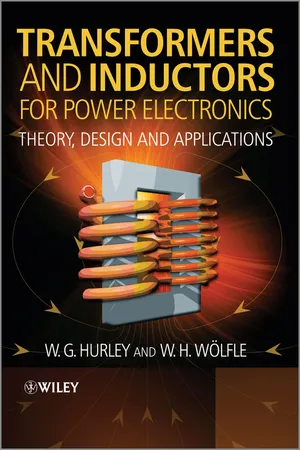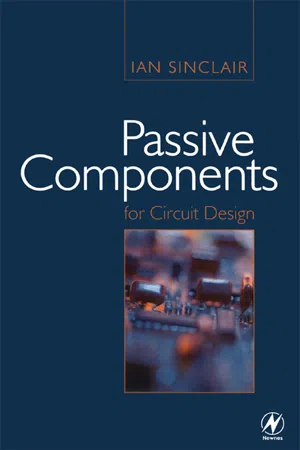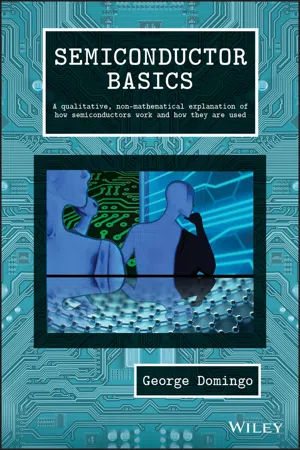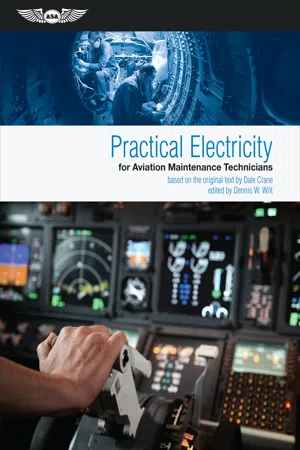Physics
Inductors
Inductors are passive electronic components that store energy in a magnetic field when an electric current passes through them. They are commonly used in circuits to control the flow of current and to store energy. Inductors are characterized by their inductance, measured in henries, and are often used in combination with capacitors to create resonant circuits.
Written by Perlego with AI-assistance
8 Key excerpts on "Inductors"
- eBook - ePub
Transformers and Inductors for Power Electronics
Theory, Design and Applications
- W.G. Hurley, W.H. Wölfle(Authors)
- 2013(Publication Date)
- Wiley(Publisher)
Section One InductorsPassage contains an image 2
Inductance1Inductors and transformers are present in almost every power electronics circuit. Broadly speaking, Inductors are dynamic energy storage devices and, as such, they are employed to provide stored energy between different operating modes in a circuit. They also act as filters for switched current waveforms. In snubber circuits, they are used to limit the rate of change of current and to provide transient current limiting. Transformers, on the other hand, are energy transfer devices, for example converting power at a high voltage and a low current to power at a lower voltage and a higher current. In a mechanical analogy, an inductor is like a flywheel which stores energy, while a transformer is like a gearbox which trades speed for torque. Besides transforming voltage levels, transformers are also used to provide electrical isolation between two parts of a circuit; to provide impedance matching between circuits for maximum power transfer; and to sense voltage and currents (potential and current transformers).2.1 Magnetic Circuits
We have seen in Chapter 1 that Ampere's law describes the relationship between the electric current and magnetic field in a magnetic circuit. Figure 2.1 shows a coil with N turns wound on a closed magnetic core of mean length l c and cross-sectional area A c , from Equation 2.1 .(2.1)Recall that the direction of H around the loop is related to i by the right hand screw rule.Figure 2.1 Magnetic circuit.At this point we need not concern ourselves with the shape of the core or the shape of the cross-section. For simplicity, we assume that the cross-section is constant over the length of the core. We also assume that the flux density is uniform over the cross-sectional area and that the value of the magnetic field intensity H c is constant around the loop C . This assumption is reasonable as long as there is no flux ‘leaking’ from the core; we can take leakage effects into account later. Thus, applying Equation 2.1 yields the expression for H c in terms of the product Ni - eBook - ePub
- Clay Rawlins(Author)
- 2000(Publication Date)
- Newnes(Publisher)
9. Given a circuit of series-connected Inductors, the applied voltage, and frequency of the applied voltage, determine the inductive reactance of each inductor, the total inductance, the total current, the voltage across each inductor, the reactive power of each inductor, and the total reactive power in the circuit.10. Given a circuit of parallel-connected Inductors, the applied voltage, and frequency of the applied voltage, determine the inductive reactance of each inductor, the total inductive reactance, the total inductance, each inductive branch current, the total current, the reactive power of each inductor, and the total reactive power in the circuit.INTRODUCTION
In the last two chapters, discussion concerned the capacitor and how to analyze circuits composed of only capacitors or capacitors and resistors. This chapter is about the remaining passive circuit element — the inductor.Figure 8.1 some types of Inductors. Basically, any inductor is a coil of thin wire wrapped on a cylinder called the core. The core may be hollow, of laminated paper — an air core — or made of some type of iron — an iron core. Often an inductor is also called a choke or coil. The turns of wire of the inductor are electrically insulated from each other by a thin, non–conductive coating.Figure 8.1 Typical InductorsAs shown in Figure 8.2 the schematic symbol used to represent the inductor resembles what it is — wire wrapped on a core. The inductor’s letter symbol is a capital L which represents linkages — flux linkages.An inductor has magnetic properties. Therefore, a brief review of the subject of magnetism should help you understand better the electrical properties of an inductor.Figure 8.2 Schematic Symbol for an InductorELECTROMAGNETIC PROPERTIES
Faraday’s DiscoveryRecall that in 1831, Michael Faraday showed that when a conductor connected in a closed circuit is moved through a magnetic field, an electron current flows as a result of a voltage induced in the conductor. (In this chapter, like in all other chapters in this book, current flow refers to electron current flow.) - No longer available |Learn more
- Robert A. Pelcovits, Joshua Farkas(Authors)
- 2023(Publication Date)
- Barrons Educational Services(Publisher)
Inductors. A useful way to think of Inductors is to imagine that they are trying to stabilize the amount of current flowing through a circuit by creating an EMF that opposes changes in current. Now that we have a qualitative understanding of Inductors, we’re ready for a more rigorous quantitative exploration of Inductors.TIP Induction occurs even when there is only one circuit.Example 16.1 The Self-Inductance of a SolenoidA solenoid of length l with n turns per length and radius R experiences a changing current dI/dt. Calculate the magnitude of the induced EMF in the solenoid.The magnetic field within the solenoid is given by Calculating the magnetic flux,SolutionQuantitative Definition of Self-Inductance
As we might expect, the induced EMF is proportional to the rate of change in the current. This proportionality constant is called self-inductance.The inductance of an inductor, L, is a property of the geometry of the inductor itself. For example, from Example 16.1 , you can verify that the inductance of a solenoid is given by the following expression that involves only physical constants and the dimensions of the inductor: L = μ0 πn2 lR2 .The SI unit for inductance is the henry (H), given by the equation 1H = 1 (V⋅s)/A.Energy Stored In an Inductor
As we increase the current through an inductor, an EMF is induced in the inductor; that is, a potential difference (voltage) develops across the two terminals of the inductor that opposes increases in current. Therefore, increasing the current in an inductor involves driving current against this potential difference, which requires energy. Where does this energy go? It is stored in the inductor. Later on, if the battery wears out and the current begins to decrease, a potential difference develops across the inductor that pushes the current in the same direction as the battery in an effort to oppose the decrease in current. At this point, the energy stored in the inductor is being depleted to maintain the current. - eBook - ePub
MSP430-based Robot Applications
A Guide to Developing Embedded Systems
- Dan Harres(Author)
- 2013(Publication Date)
- Newnes(Publisher)
Figure 3.23 is actually just an inductor. In most instances the wire will be wound around some type of ferromagnetic material, such as iron but there are also Inductors made that have no material in the center. These Inductors are referred to as “air-core Inductors”.Storing energy in capacitors and Inductors
The electric field built up in a capacitor and the magnetic field built up with an inductor can be very useful. Consider the capacitor of Figure 3.21 . If we remove the battery connection to that capacitor, it continues to stay charged and maintains the voltage across its plates until such a time as the capacitor is connected to a circuit that draws current from the capacitor, at which point its voltage will begin to drop in accordance with Eq. 3.14 . Large-value capacitors are sometimes used in this way as a replacement for batteries.We will also see in a later section of this chapter that the capacitor’s ability to store charge and its corresponding ability to resist rapid changes in voltage makes it very useful in holding up voltages in circuits that may experience fluctuations in supply voltage.Making analog filters out of resistors, capacitors and Inductors
An analog filter is a circuit that operates on AC signals. Remember from the beginning of this chapter that an AC signal is one which is changing. As we’ve seen earlier, capacitors impede changes in voltage and Inductors impede changes in current. Equations 3.14 and 3.25 give us a clue that the amount of this impedance is time-dependent which, in turn, tells us something about the device’s response to changing signal frequency.Resistor/capacitor filters
Frequency is the number of cycles of change per second. It is given the unit hertz (abbreviated Hz), where 1 Hz=1 cycle per second. The higher the frequency of a signal, the faster it changes with time. Reviewing Eq. 3.14 - eBook - ePub
- Ian Sinclair(Author)
- 2000(Publication Date)
- Newnes(Publisher)
Chapter 5Inductors and inductive components
Induction and inductance
Electromagnetic induction was discovered by Michael Faraday in 1831. The principle is that an EMF (a voltage) is generated in a conductor when the magnetic field across the conductor changes. In the early experiments, the change of magnetic field was accomplished by moving either the wire or a magnet, and this is the principle of the alternator and dynamo. An EMF can also be induced without mechanical movement, when the strength or direction of a magnetic field across a wire is altered, and even the presence of a wire is not necessary, because the alteration in a magnetic field can produce an electric field in the absence of any conductor. Inductive components in electronics make use of the EMF that is generated when a field changes either in the same piece of wire (self-induction ) or in another piece of wire (mutual induction ).The amount of EMF that is generated in a wire can be greatly increased if the wire is wound into a coil, and as much as possible of the magnetic field is guided through the coil. Figure 5.1 shows the flux path in a solenoidal winding for a steady current. Concentration and guidance of the magnetic field is achieved by using a magnetic core, for which the traditional material was annealed ‘soft’ iron. One way of looking at a soft iron core is as a conductor for magnetism, using the idea of magnetic flux. It is possible to think of magnetic circuits in which magnetic flux (φ) is the counterpart of current, in a path which has reluctance (analogous to resistance), and in which the amount of flux is produced by a magnetomotive force (MMF). The equation that is the magnetic equivalent of V = R × I - eBook - ePub
- Jo Verhaevert(Author)
- 2024(Publication Date)
- Routledge(Publisher)
Chapter 5 Electromagnetism
DOI: 10.1201/9781003308294-5Learning Outcomes This chapter concerns the principles and laws governing electromagnetic induction and the concepts of self and mutual inductance. On completion of this chapter you should be able to use these principles to:- Understand the basic operating principles of motors and generators.
- Carry out simple calculations involving the generation of voltage, and the production of force and torque.
- Appreciate the significance of eddy current loss.
- Determine the value of Inductors, and apply the concepts of self and mutual inductance to the operating principles of transformers.
- Calculate the energy stored in a magnetic field.
- Explain the principle of the moving coil metre and carry out simple calculations for the instrument.
5.1 Faraday’s Law of Electromagnetic Induction
It is mainly due to the pioneering work of Michael Faraday, in the nineteenth century, that the modern technological world exists as we know it. Without the development of the generation of electrical power, such advances would have been impossible. Thus, although the concepts involved with electromagnetic induction are very simple, they have far-reaching influence. Faraday’s law is best considered in two interrelated parts:- The value of emf induced in a circuit or conductor is directly proportional to the rate of change of magnetic flux linking with it.
- The polarity of such an emf, induced by an increasing flux, is opposite to that induced by a decreasing flux.
The key to electromagnetic induction is contained in part 1 of the law quoted above. Here, the words ‘rate of change’ are used. If there is no change in flux, or the way in which this flux links with a conductor, then no emf will be induced. The proof of the law can be very simply demonstrated. Consider a coil of wire, a permanent bar magnet and a galvanometer as illustrated in Figures 5.1 and 5.2 - eBook - ePub
Semiconductor Basics
A Qualitative, Non-mathematical Explanation of How Semiconductors Work and How They are Used
- George Domingo(Author)
- 2020(Publication Date)
- Wiley(Publisher)
6 Other Electrical ComponentsOBJECTIVES OF THIS CHAPTER
After explaining how the diode operates, I was eager to start discussing some of its applications. I realized, though, that there are other electrical passive components that are necessary to design useful electronic circuits and we need to understand them. Therefore, after a digression on voltage and current, both direct and alternating, I discuss three electrical/electronical components: the resistor, the capacitor, and the inductor. The first two are indispensable to creating working electronic circuits and systems. Inductors are not as commonly used, partly because it is awkward to fabricate them in a miniaturized setting. Some of you may already be familiar with these elements and may want to scan or skip this chapter.6.1 Voltage and Current
First, just a comment about voltage and current, which sometimes are confused. Let me explain the difference using the analog of fluids. As a matter of fact, there is a field call fluidics that mimics electronic circuits, but it uses liquids, fluids, instead of electrons.To have motion of fluids you need, obviously, the fluid. You also need a path for the fluid to move through and a force, a pump or just gravity, to push the fluid through the chosen path. The same is true in an electrical system. The battery or the generator is the equivalent of the pump. The batteries sitting in your drawer have an electrical potential which we call voltage and the units are measured in volts, the same way that the water can be stored up in a water tank with sufficient potential energy to come down as soon as we provide a path. In the case of a battery, the voltage is typically 1.5 V. The energy provided by the chemical composition is inside the battery no matter if the battery is or is not connected. If I connect the battery to a light bulb, as in a flashlight, current flows and the light is on until the energy stored in the battery is completely spent (after many uses you need to replace the batteries). The same thing happens with a water tank. The water will stay up there until we provide a path and the water continues flowing until the tank is empty. - Dale Crane, Dennis Wilt(Authors)
- 2017(Publication Date)
- Aviation Supplies & Academics, Inc.(Publisher)
B. The current flows rapidly at first and then tapers off as the voltage across the capacitor rises. When the voltage across the capacitor reaches the voltage of the battery, no more current flows. C. Time constant when the capacitor is charging. D. Time constant when the capacitor is discharging.InductorsEnergy stored in the electrostatic field in a capacitor is caused by the voltage that holds the electrons in the capacitor. Electrical energy can also be stored in an inductor in an electromagnetic field, and the amount of energy stored in these fields depends upon the inductance and the amount of current.Self-InductionWhen current flows in a conductor, it causes a magnetic field to surround the conductor, and the direction the lines of flux encircling the conductor is determined by the direction of the current flow. The distance the field extends out from the conductor is determined by the amount of current flowing in the conductor.Figure 4-28 . Anytime current flows in a conductor, a magnetic field surrounds it. When the current flow changes, the magnetic field builds up or collapses. As it does, it cuts across the conductor and induces a current in it. This induced current flows in a direction opposite to that of the current which caused it.When lines of magnetic flux cut across a conductor, a voltage is generated in the conductor that causes current to flow, and lines of flux cut across a conductor any time the current flowing in the conductor changes. If a coil is connected across a battery, as in Figure 4-29, the current will begin to flow as soon as the switch is closed.Figure 4-29 . As soon as the switch is closed, current begins to flow (it changes from zero flow to maximum flow). This changing current induces a voltage in the coil.Lenz’s law states that an induced current is produced in a conductor any time the current flowing through it changes. This current causes lines of magnetic flux to cut across the conductor. The direction of the induced current is always opposite to the direction of the source current, and the amount of induced current is determined by the rate at which the lines of flux cut across the conductor. This induced current is produced by self-induction.
Index pages curate the most relevant extracts from our library of academic textbooks. They’ve been created using an in-house natural language model (NLM), each adding context and meaning to key research topics.
Explore more topic indexes
Explore more topic indexes
1 of 6
Explore more topic indexes
1 of 4







